How Close Is the Smart Factory of the Future?

Manufacturing is marching toward a future that is highly automated, intelligent and flexible.
Increasingly, smart factories are made up of connected machines that generate large amounts of data. This opens the door for artificial intelligence–driven analysis and new opportunities for insights on improving supply chains, processes, the customer experience, product quality and more.
But realizing this transformation can be difficult. Not all manufacturers have the resources, capital or talent required for a smart factory future. How are companies progressing on this journey, and what challenges stand in the way? To find out, the Manufacturing Leadership Council—the NAM’s digital transformation arm—conducted its Smart Factories and Digital Production survey.
Manufacturers are committed to M4.0: When it comes to digital technology, manufacturers are spending at a steady—and in some cases growing—basis.
- Nearly 69% of survey respondents said their M4.0 investments this year would continue unchanged from last year.
- Nearly 19% said they would increase investments, while just 10% said their investments would likely decline.
- Some 58% assessed their company’s digital maturity level in manufacturing operations at three to five on a scale of 10, suggesting the industry has moved beyond the initial stages of M4.0 and has reached an early majority of digital-model adoption.
How widespread are digital factories? Only about 7% of manufacturers say they have digitized their factory operations extensively.
- Approximately 15% expect to have their manufacturing operations digitized end-to-end by 2026.
- About 5% say their factories are already “very smart.”
- Approximately 53% say their factories and plants are getting smarter but are still works in progress.
In the future, will factories run themselves? While some manufacturers foresee a future of “lights out” factories, or those that mostly run themselves, most don’t think they will ever reach that state.
- About 49% of respondents expect fully or partially autonomous factories in the future.
- Some 40% say AI will be either very significant or somewhat significant in the years to come.
- Approximately 56% cite organizational resistance to change as the top barrier to implementing a smart factory.
For more details on these findings and the impact of smart factories as a whole, read the survey report: Smart Factories Are Still a Work in Progress.
What’s Ahead for Manufacturing in 2024?

Getting a solid forecast of the year’s key issues in manufacturing can help your business prepare for anything. A panel of experts recently shared their 2024 outlook in the webinar “What’s Ahead for Manufacturing in 2024?” hosted by the Manufacturing Leadership Council, the NAM’s digital transformation arm.
They offered insights on the 2024 manufacturing economy, legislative climate, digital trends, resilience strategies and more.
Economic outlook: NAM Chief Economist Chad Moutray provided a manufacturing economic update.
Key takeaways:
- The NAM Q4 2023 Manufacturers’ Outlook Survey revealed that more than 66% of member companies have a positive economic outlook for 2024, yet opinions are mixed on whether there will be a recession.
- The top economic challenge this year will be the workforce, with the labor market cooling substantially but remaining tight, Moutray said.
- Private manufacturing construction spending is at an all-time high of $210 billion thanks to the production of semiconductors, electric vehicles and batteries, and general reshoring.
- Risks this year include geopolitical turmoil, slow global economic growth, cost pressures, talk of a recession and labor issues, among others.
Policy perspective: NAM Vice President of Domestic Policy Charles Crain gave an overview of the current climate in Washington, D.C., and the NAM’s legislative priorities.
Key takeaways:
- The NAM will continue its focus on tax policy following House passage of an NAM-supported bipartisan tax package that would reinstate three manufacturing-critical tax provisions.
- Manufacturing is facing a regulatory onslaught, with the average manufacturer paying $29,000 per employee per year due to unbalanced, burdensome regulations, according to a recent NAM-commissioned study.
- Artificial intelligence is a hot topic on Capitol Hill, with 60 AI-related bills introduced in Congress last year. The NAM is working to help policymakers understand the benefits of AI, including safety, worker training, product design and development, and efficiency.
Manufacturing 4.0 Trends: MLC Senior Content Director Penelope Brown offered a look at digital manufacturing trends on the horizon.
Key takeaways:
- Manufacturers can expect to see a broader adoption of existing AI applications, including predictive/preventative maintenance, improved processes and enhanced productivity.
- According to the MLC’s recent Smart Factories and Digital Production survey, 65% of manufacturers anticipate their level of M4.0 investment this year will stay the same as last year.
- Other trends to watch include the rise of global partnerships such as Catena-X and CESMII, digitized supply chains and reshoring.
Resilience perspective: Cooley Group President and CEO (and MLC Board of Governors Chair) Dan Dwight shared his approach to resilience in 2024 and the years to come.
Key takeaways:
- Business leaders should prioritize agility and adaptability, even if it means admitting to suboptimal results that require redirection.
- Resilience doesn’t mean perfection; it means learning from failures.
- AI and machine learning contribute to resilience by building out end-to-end visibility across an organization—from vendors to manufacturing operations to customers.
For additional details from these experts, watch “What’s Ahead for Manufacturing in 2024?”
Connect, Analyze, Improve — Then Rinse and Repeat
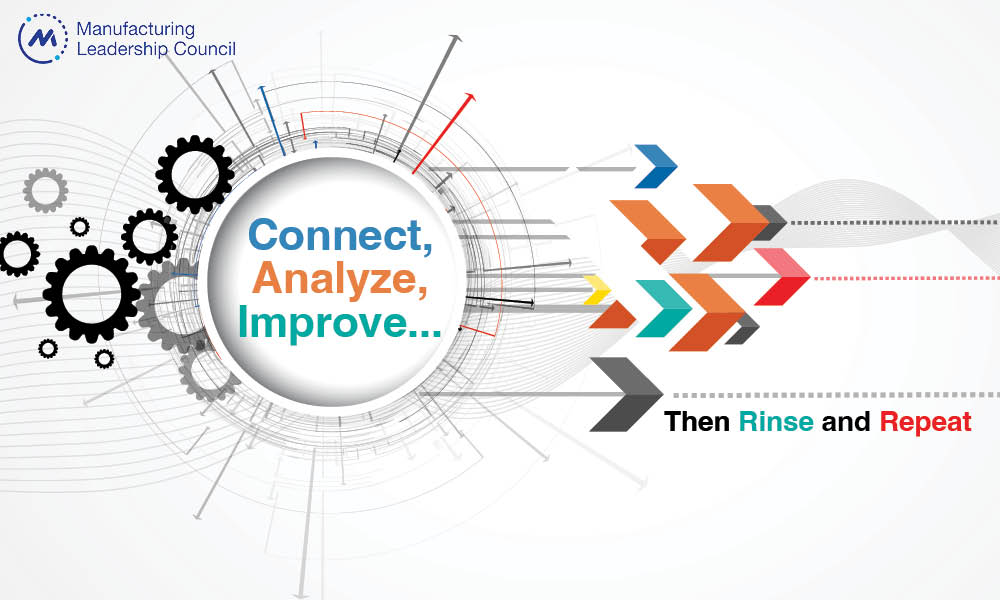
A focus on connecting equipment and then using data to make improvements can create a solid foundation for smart manufacturing.

TAKEAWAYS:
● While manufacturers have embarked on the M4.0 journey and expect it to accelerate, many are still struggling with where to begin.
● A good place to focus is on connecting equipment and then using the data and AI to make improvements in operations.
● As pilot projects build organizational confidence and knowledge, the lessons learned can be applied to other areas of the business.
From conversations at the Manufacturing Leadership Council’s December 2023 Manufacturing in 2030 event, it became clear that the industry is still far from delivering on the vision of Industry 4.0. Although we have been discussing the value of industry 4.0 for over 20 years, companies continue to be challenged on how to drive progress – and for some on even how to get started.
There’s a natural tendency to want to have a cohesive plan or strategy for moving ahead. In the MLC’s recent study, Manufacturers Go All-In on AI, 42% of manufacturing executives cited the lack of comprehensive M4.0 strategy as the top challenge to adopting and using those technologies. Another 37% said the biggest hurdle is their ability to assess the cost/benefit of deployment.
Navigating through the wide array of technologies to develop a M4.0 strategy is challenging. Thinking too broadly can lead to analysis paralysis; thinking too narrowly can make it difficult to demonstrate a level of ROI that warrants investment—especially in the current economic climate.
Cooley Group president and CEO Dan Dwight spoke at the event and offered advice that resonated: “Just get started.”
What does that mean? In our experience working with manufacturing organizations to become digital, making positive strides doesn’t have to be complicated or time-consuming, or even expensive. Find a clear business problem — increasing throughput by improving overall equipment effectiveness or reducing costs by improving quality — that can be solved with better or more timely data from your equipment. Gather data from the equipment involved and analyze that data using a readily available technologies like an industrial AI operating system consisting of an edge platform (data collection), machine learning platform (data analytics), and cloud platform (data management) for a hybrid unified analytics experience. Manufacturers win when they trust their digital partners (system integrators) in deploying these technology solutions in production, at scale.
When done well, this not only solves a problem but also creates a foundation for expanding beyond the pilot and exploring more opportunities to benefit from the technology investment and what your organization has learned.
A Case Study in “Just Get Started”
Our partnership in working for a pet food manufacturer highlights the potential for this approach.
Pet adoptions swelled during the pandemic, accelerating the company’s already rapid growth and challenging its ability to meet demand. Management wanted to increase operational agility to respond better to shifts in demand.
A rapid assessment of operations revealed an opportunity to pilot smart manufacturing technology to better understand what was happening on production lines, including machine availability, to improve efficiency and throughput. We used an industrial automation platform to connect 31 machines across four departments to gather and analyze performance data.
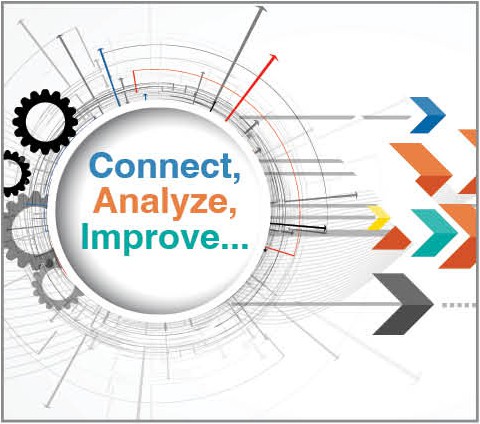
“Thinking too broadly can lead to analysis paralysis; thinking too narrowly can make it difficult to demonstrate a level of ROI that warrants investment.”
This allowed frontline leaders to visualize what machines were doing: Were they up, down, or idle when not expected? Engineers could then look more closely at potential maintenance or other issues. For example, the cumulative production volume would briefly zero out. Further analysis found that trays were getting stuck, thus shutting down the line. Through investigation, we found that operators had performed a hard shutdown of the line to clear the issue, which had negative consequences for the computer equipment. This is a prime example of how root cause analysis, enabled by insight from machine data, helped the company identify and take action for technical, behavioral, and process issues.
The project coupled data insights from the connected equipment with basic management practices to develop new metrics and scorecards, controls, and communication processes across functions and shifts so that employees from management to the shop floor had access to the right data and could use it to optimize operations. Because the machines are connected and delivering real-time data, teams can now see production line status and take action closer to real-time, all without the need for manual data collection.
This solution was simple to set up, allowing us to begin connecting machines within eight weeks. Within 16 weeks, the company was using data to improve its production loss tracking process. The increased throughput translated to an estimated $13 million in incremental capacity, and the project paid for itself within 16 weeks — 10 weeks before it ended. This allowed extra attention to change management to increase knowledge, ownership, and buy-in.
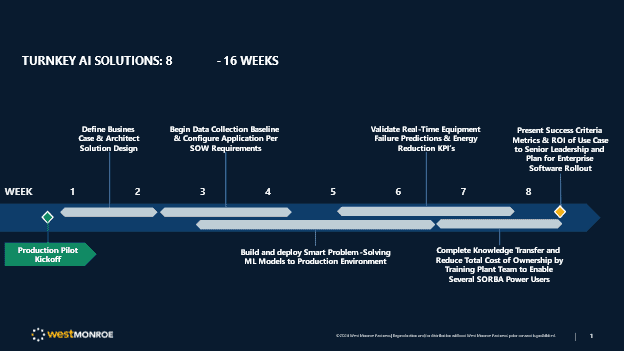
It’s important to reinforce that this was the company’s first foray into smart manufacturing. Four key factors made our efforts successful:
- Identifying a specific and focused business problem and goal for the insight required to address the problem
- Getting buy-in from management to “just get started” as opposed to ongoing debate on the potential value
- Employing available technology to gather the data required
- Using analysis to make operational changes, addressing the people side of change as well as the technology
With this success, the company now had a M4.0 foundation on which it could continue building.
A Case Study in Building on the Foundation
This particular application of M4.0 technology can address multiple operational needs and goals around predictive maintenance, quality control, supply chain optimization, and energy efficiency and sustainability.
In a report for the U.S. Department of Energy, the Lawrence Berkeley National Laboratory studied motor systems in the industrial and commercial building sectors. Among the findings: 75% of industrial motor system electricity consumption is attributed to 1-1500 hp motor systems; however, a lack of sufficient data is a major barrier to capturing energy savings potential in these motor systems. With the increasing pressure on mid-market manufacturers to demonstrate their efforts to curb carbon emissions by their customers, energy monitoring and reduction in manufacturing operations benefits both the top-line and bottom-line.
Starting the journey with a focus on energy efficiency often leads to opportunities to use the same technology to derive benefits in other areas. This has been the case for a Fortune 100 food and beverage company. The organization wanted to reduce fuel waste in high-use assets like compressors and boilers, particularly the steam consumption of wort kettles. In this case, lack of machine data and insights prevented the company from addressing this issue effectively.
The company wanted to pilot a program that allowed real-time AI industrial optimization techniques to improve energy consumption and efficiency, using a platform that would work in different brewery environments. The focus of the pilot project centered around using the SORBA.ai platform to connect the following energy and fluids functions (machine profiles):
- Compressors (ammonia and air) and condensers
- Boilers (biofuel and natural gas), filtration skids, and wort kettles
- Heat exchangers, cooling towers, HVAC equipment, and co-gen turbine engines
The goal for the AI was to optimize performance and improve machine efficiencies, which directly correlates to a reduction in energy consumption. The AI allowed the company to autonomously draw and analyze real-time data to produce insights for optimizing the control of equipment use.
In conjunction, the company equipped 200+ front-line AI users — including developers, engineers, operators, and consultants — with enhanced skills and digital tools to abstract insight, use it to optimize operations, and sustain that performance over time.
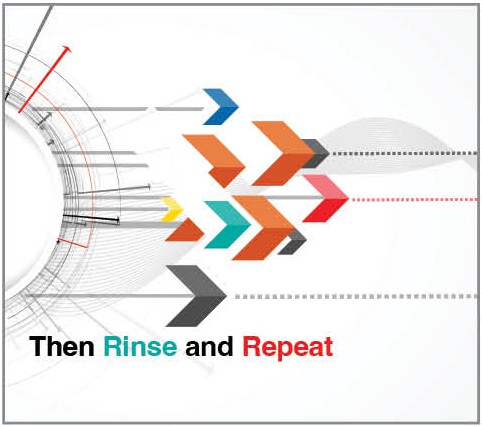
“Starting the journey with a focus on energy efficiency often leads to opportunities to use the same technology to derive benefits in other areas.”
The pilot project reduced fuel and electricity consumption by 5-10%, translating to $100,000 in annual savings per facility/per two use cases—generating a 5x return on investment in less than two years.
More significantly, what started as an energy efficiency project has today grown to include use cases and benefits in other parts of the business:
- Offset of carbon emissions per ton reporting, validated by Department of Energy audits.
- Production capacity increases. By using the same AI technology to optimize control of filtration skids, the company removed capacity constraints, maximizing material flow. As a result, it was able to produce hundreds more barrels of product per specialized membrane filter machine, per production run. This increased production throughput equates to a forecasted gain of $50 million in revenue realized over five years.
- Supply chain optimization. The company reduced technical debt (custom models, rework, data integration) across the supply chain by 33% from raw material (harvested grains) to packaging (bottled and shipped product).
- Quality control. An ancillary benefit of reducing energy through AI process optimization technology helped quality control technicians responsible for the wort kettle process analyze random batch samples and reduce protein coagulation in real-time.
Build the Foundation while Building the Future
Connecting equipment and leveraging machine data is a great way to begin building the foundation for smart manufacturing, and move in the direction of robust strategy around advanced capabilities such as digital twin or simulation. It also helps the organization increase M4.0 maturity, as people learn to use insight and optimize operations.
If you’re struggling with where to focus effort or even where to begin, you aren’t alone. A good way to establish and build momentum is to focus on connecting equipment to gather and use data. Find a use case. Use available technology to connect equipment and gather data. Then analyze the data, learn, apply what you’ve learned, and repeat. As you do, you’ll see the momentum begin to build as the data leads you. M
About the authors:

Randal Kenworthy is Senior Partner, Consumer & Industrial Products at West Monroe

Kris Slozak is Director, Consumer & Industrial Products at West Monroe

AJ Alexander is Managing Director at Sorba.ai
Safeguarding Smart Manufacturing Against Cyberattacks
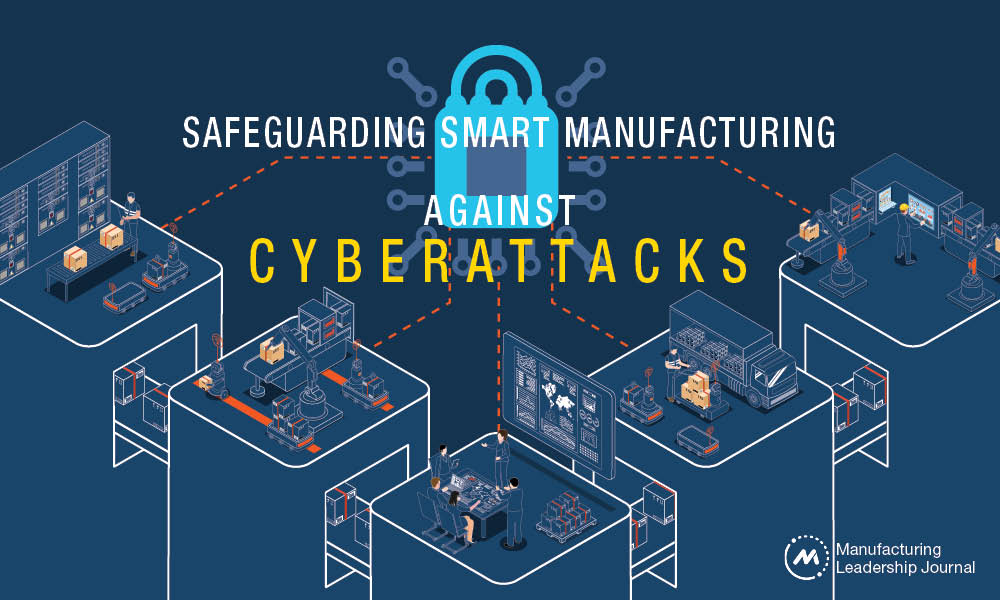
Placing risk management and threat scenario planning at the intersection of smart manufacturing and cybersecurity can fortify organizations.

TAKEAWAYS:
● The arrival of smart manufacturing, driven by AI and advanced technologies, necessitates a paradigm shift in how manufacturers approach cybersecurity.
● Manufacturing systems and facilities are interconnected, making them vulnerable to cyberattacks that can exploit systems at scale.
● Manufacturers can safeguard against cybersecurity threats by leveraging threat scenarios and adopting vigilant but practical risk management practices.
Manufacturers are increasingly leveraging AI-driven or smart manufacturing technologies to enhance their production processes and improve their bottom line. As businesses chart their course for the next five years, data analytics, increased automation, and the adoption of smart manufacturing and cloud technologies are driving forces for growth. Predictive maintenance, quality control, inventory management, supply chain optimization, and autonomous robots are revolutionizing manufacturing by boosting efficiency, quality, and safety. According to the Rockwell State of Smart Manufacturing Survey, most organizations recognize the importance of smart manufacturing, with 45% planning to adopt it within the next year and an additional 39% within 1-2 years. Over 50% more manufacturers are using machine learning and AI technologies than just a year ago, so the transformation is accelerating quickly. In fact, the Manufacturing Leadership Council’s 2023 Transformative Technology survey reveals that 63% of respondents expect Manufacturing 4.0 technology adoption to accelerate in the next two years.
All these transformative technologies share a common requirement: the need for a fortified cybersecurity strategy. Manufacturers must recognize cybersecurity as an integral component of their digital transformation journey. It is not just an afterthought, but rather the first and last question on the journey toward realizing smart manufacturing’s full potential. Establishing a robust cybersecurity strategy involves setting up the right governance structure, integrating technology with people, and focusing on progress over perfection.
The Complexity of Manufacturing Systems
Manufacturing systems are intricately interconnected, making them susceptible to cascading impacts in the event of a cyberattack. As technology evolves, manufacturers are moving from heterogeneous to homogeneous infrastructures, transitioning from purpose-built control system environments with different integrators, OEMs, and profiles to common operating systems, network protocols, and software stacks.
An attack on one system can reverberate through an entire plant, resulting in substantial revenue losses. The similarities between environments also provide an unintended advantage for adversaries – the learning curve is easier, and groups can develop impactful malware at scale.

“An attack on one system can reverberate through an entire plant, resulting in substantial revenue losses.”
The consequences of cyberattacks on manufacturing operations can be far-reaching and detrimental, affecting key components for operations, productivity, and safety. Depending on the malware functions and attack intentions, attacks can target manufacturing operations by affecting any of the three main systems of a plant:
- Manufacturing Execution Systems (MES): MES systems play a pivotal role in data interchange between business and operations, making them prime targets for cyberattacks.
- Plant Floor Assets: Assets like Human Machine Interfaces (HMIs) and controllers are indispensable for controlling equipment and processes. Disruption of these systems can bring manufacturing production to a standstill.
- Enterprise Resource Management (ERP): ERP systems, centralizing plant data, downtimes, and production constraints, are crucial to the manufacturing industry’s corporate side.
These interdependencies underscore the importance of threat scenarios as essential components of cybersecurity planning for operational technology environments.
Threat scenarios simplify the process of risk assessment by identifying and prioritizing vulnerabilities that hold the utmost relevance in your specific environment, thus aiding in the allocation of resources. Simulated threat scenarios serve as litmus tests for assessing your level of preparedness, enabling manufacturers to pinpoint security control gaps effectively. By using realistic scenarios, you can strategically engineer your architectures to defend against the most probable Tactics, Techniques, and Procedures (TTPs).
Threat scenario analysis concentrates the deployment of security controls on those areas with the highest risks, fostering proactive defense measures. These scenarios enhance incident response planning, facilitating the development of effective strategies, role definitions, and containment and recovery procedures. Well-understood threat scenarios unite different teams across your enterprise, and you can rally around them to promote a continuous improvement culture through regular employee training.

“The consequences of cyberattacks on manufacturing operations can be far-reaching and detrimental for operations, productivity and safety.”
Step-by-Step Guidance for Using Threat Scenarios to Improve Your Cybersecurity Program
Step 1: Choose Threat Scenarios: Select three to four threat scenarios that resonate most with your sub-sector and environment. These will be the focal points of your cybersecurity strategy.
Dragos recommends starting with these four common scenarios for manufacturing environments:
- Ransomware: Ransomware attacks are a significant concern, with their initial access stemming from various sources such as remote connections or leveraging information technologies/operational technologies (IT/OT) dependencies. These attacks involve exfiltrating information, encrypting files, and locking compromised computing systems, demanding ransom payments for their release.
- Trusted Vendor Compromise: Trusted vendors may unwittingly become conduits for cyberattacks when their software becomes compromised before distribution. These attacks can disrupt the supply chain.
- Shared IT/OT Dependencies: OT systems’ reliance on IT systems or insecure remote access into OT environments can result in IT compromises affecting OT, potentially causing disruptions.
- PIPEDREAM: PIPEDREAM is a highly scalable industrial malware that targets industrial control systems. While it was detected and analyzed in 2022, it remains a potential threat, underlining the need for preparedness.
Step 2: Identify Crown Jewels: Identify the critical assets within your environment — typically constituting about 25% of your infrastructure — and prioritize their protection.
Step 3: Align Around the SANS Five Critical Controls: Dragos and the SANS Institute undertook extensive research to discern the most effective measures to counter incidents within Industrial Control System (ICS) environments. These efforts resulted in the formulation of the SANS Five Critical Controls, a concise framework that outlines essential steps manufacturers must take to establish a robust security strategy against genuine threats.

“Threat scenarios simplify the process of risk assessment by identifying and prioritizing vulnerabilities that hold the utmost relevance.”
The SANS Five Critical Controls include:
- Incident Response: To effectively address cybersecurity incidents, it is imperative to envision and plan for the worst-case scenarios. What does a “bad day” look like, and how should your security program respond to such scenarios? Focus on scenarios that hold real relevance to your specific industry and environment, avoiding theoretical exercises in favor of real-life, industry-specific threats. Get a thorough understanding of the risks involved by meticulously examining each scenario from inception to resolution. Select three to four scenarios, like the ones listed above, and reverse-engineer strategies for handling them effectively.
- Defensible Architecture: A well-designed and segmented architecture forms the bedrock of a defensible cybersecurity strategy. It should empower human defenders to thwart human adversaries effectively. Consider whether your architecture can support the collection of critical data needed for incident response. While IT predominantly deals with data and systems, OT encompasses systems of systems and physics. Failing to account for the transient nature of data in OT can be detrimental during investigations and incident recovery.
- Visibility and Monitoring: Achieving comprehensive visibility across your network is indispensable. It involves monitoring control system protocols and communications within your processes, reinforcing the foundation of a defensible architecture. Operational resilience hinges on the ability to conduct root cause analysis, enabling the detection of threats and understanding the scenarios most likely to impact your environment. This should align with your organization’s unique priorities.
- Secure Remote Access: Secure remote access demands multifactor authentication and meticulous supply chain management. Interconnectedness exposes your risk to the risks of others, emphasizing the need for a robust approach to remote access.
- Vulnerability Management: Effective vulnerability management is not about indiscriminate patching but focuses on the vital 2-4% of vulnerabilities that truly matter. Identifying these vulnerabilities and knowing how to address them is essential.
In concert, these five critical controls constitute the foundation of a potent cybersecurity program and give you something to measure against.
Step 4: Conduct a Risk Assessment: Assess the current state of your environment to understand existing vulnerabilities and potential risks.
Step 5: Identify Gaps and Priorities: Based on your risk assessment, identify gaps in your cybersecurity defenses and establish priorities for mitigating them. This step forms the basis for your cybersecurity roadmap.
The Bottom Line: Adopt a Vigilant – But Practical – Risk Management Strategy
The advent of smart manufacturing, driven by AI and advanced technologies, necessitates a paradigm shift in how manufacturers approach cybersecurity. It must be an integral and proactive component of your digital transformation journey. By leveraging threat scenarios and adopting a vigilant but practical stance toward risk management, manufacturers can safeguard their operations, protect sensitive data, and position themselves for success in an evolving landscape where innovation and security must go hand in hand. M
About the Author:

Michael Sakmar is the Vice President of Professional Services at Dragos, Inc., where he leads teams of consultants in performing active defense inside of ICS/OT environments. He is responsible for a range of services such as architecture assessments, penetration testing, tabletop exercises, and incident response.
Welcome New Members of the MLC February 2024
Introducing the latest new members to the Manufacturing Leadership Council


Kelley Brna
VP, Operations
Merck & Co., Inc.

merck.com/
![]()
https://www.linkedin.com/in/kelley-brna-22037334/

Bryan Van Itallie
President
Pratt Intermodal Chassis

prattchassis.com/
![]()
https://www.linkedin.com/in/vanitallie/
Technologies for the Factory of the Future
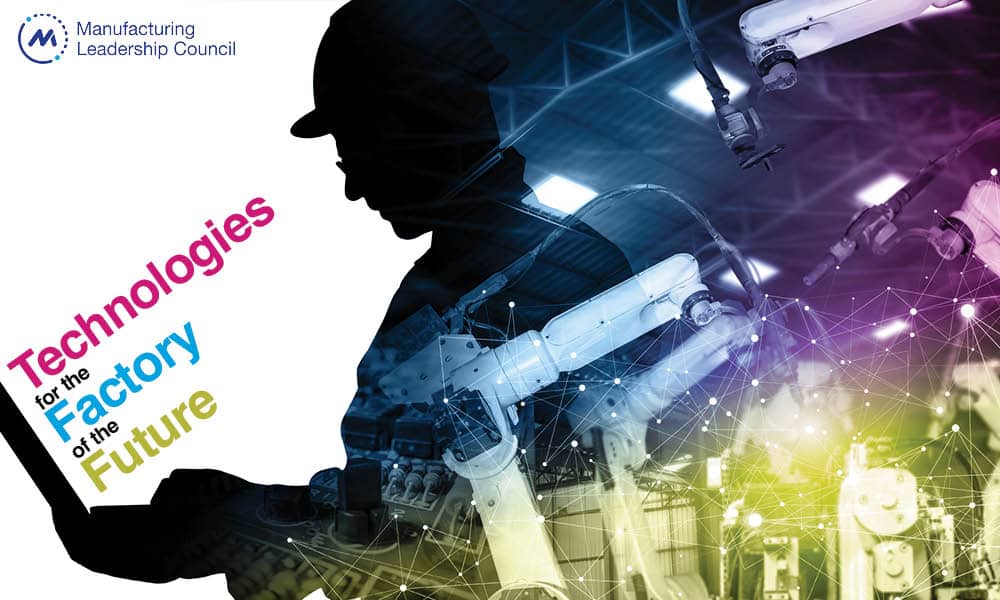
To future-proof manufacturing, drive profits and serve customers, organizations must examine supply chains, sustainability, digital transformation and more

TAKEAWAYS:
● The foundation for manufacturing’s future is data and organizations’ ability to effectively capture and use data in every factory element.
● Manufacturers need to think beyond operations when they apply Manufacturing 4.0 so that they also evolve their supply chains and sustainability efforts.
● AI/ML and virtual tools can have big effects that can be amplified with collaboration, optimization and continuous improvement.
Globally, manufacturers are experiencing growing pressure to reduce carbon emissions in their production processes. The manufacturing industry is characterized by disruptions and volatility, supply chain problems, upcoming inflation, and increased financial costs, making it paramount that manufacturers find innovative solutions to face the challenges ahead.
Sustainability issues and digital transformation have become the main drivers for the next three to five years and that will shape the future of the manufacturing industry towards 2030. These trends drive the necessity of true innovation further. Even though there has been plenty of focus on buzzwords like Industry 5.0 and similar, this is now becoming a reality. The path forward is clear: manufacturers must engender greater resilience and future readiness by optimizing resource usage, minimizing waste, and embracing renewable energy sources. However, the difficulty lies in simultaneously ensuring profitable operations.
Embrace the Future of Manufacturing Through Data
A key component in all the trends and challenges is data, like reliable data on environmental sustainability, traceability throughout the value chain and product life cycle, and real-time data to detect supply chain disruptions.
For manufacturing companies, emerging technologies help expand the opportunities to become a data-driven factory of the future. Using low-cost sensors and IoT, gathering data throughout the manufacturing process is now possible. With advanced AI and machine learning algorithms, organizations can enable predictive maintenance of expensive manufacturing machinery and reduce costs and downtime. Digital twins can enable virtual simulation of development, testing, and validation of products, and AR/VR can even let customers try products before they are made.
Implement Resilient Supply Chains
Better visibility of the supply chain can lead to a more flexible manufacturing value network. For example, production can either be moved in-house or outsourced to an alternate location when a disruption occurs without adversely affecting operations.
Four clusters of disruptive digital technologies will enable supply chain digitization.
- Commodity IoT sensors with the ability to capture and process data and connect/exchange data with other systems over communications networks to provide transparency.
- Cloud computing and access to advanced algorithms enable organizations to derive insight, model, analyze and make accurate predictions to provide flexibility and efficiency.
- Technologies like robotics, business process management and robotic process automation, and voice assistants and chatbots enable the automation of physical and non-physical processes, leading to faster and more efficient processing.
- Combining disparate IT and OT data sources into a single system to generate digital operational insights and business KPIs at an enterprise level.
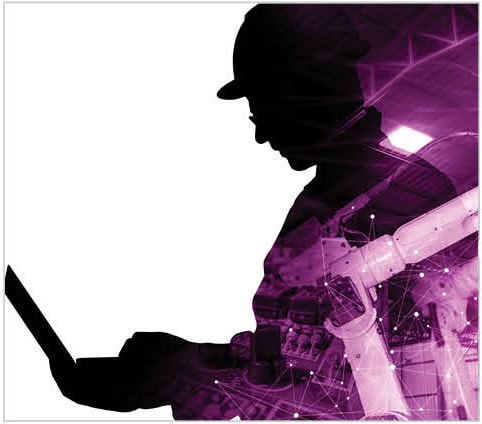
“Manufacturers must engender greater resilience and future readiness by optimizing resource usage, minimizing waste, and embracing renewable energy sources”
Achieve More Sustainable Manufacturing Practices
Reducing waste production is an important step in achieving more sustainable manufacturing practices. Currently, approximately 300 million tons of plastic waste is produced every year. By implementing a waste reduction program, designing products for sustainability, implementing lean manufacturing principles, using technology to optimize processes, product lifecycle management, e-waste management, and partnering with suppliers, manufacturers can reduce waste, conserve resources, and minimize their environmental impact. This helps meet the growing demand from eco-conscious consumers for sustainable products and benefits the bottom line of manufacturers.
Five Steps to Becoming A Future-Proof Manufacturer
A future-proof strategy for manufacturing sustainability will therefore demand internal systems that measure sustainability impacts that are commonplace to count today and those that are likely to be tomorrow. What raw materials are being used? How much fresh water is the process consuming? How much energy is being used in the process, and what are the primary energy sources? Soon we will likely see tools that automatically collect and require all digital data on sustainability indicators for products and services.
1. The Virtual Twin Experience
A virtual twin is a real-time virtual representation of a product, manufacturing or supply chain that can be used to model, visualize, predict and provide feedback on properties and performance. Virtual twin technologies provide an opportunity to reduce operational costs and waste and drive efficiency and innovation across the value chain. A Virtual Twin Experience can help companies develop the digital manufacturing and supply chain of the future.
2. Optimization
Optimization is a mathematical approach for decision-making to get the best outcome under conditions or constraints, like requiring the allocation of scarce or limited resources. A smart, autonomous and integrated optimizer is key to addressing the dynamically evolving challenges like:
- Reducing manufacturing costs and maximizing fulfillment through plant layout, facility and production planning, scheduling and sequencing
- Minimizing transportation costs through efficient flow and storage of goods from point-of-origin to point-of-consumption
- Minimizing labor costs by creating staffing plans to meet demand, while respecting shift preferences, labor regulations, vacations, etc.

“A future-proof strategy for manufacturing sustainability will demand internal systems that measure sustainability impacts that are commonplace today and those that are likely to be tomorrow”
3. Artificial Intelligence (AI) and Machine Learning (ML)
Manufacturers have more data than ever before, which makes AI/ML ripe for disruption. AI/ML is a game changer for manufacturing and supply chain as it has the potential to offer CAPEX-free productivity improvements. Through sophisticated pattern recognition, AI/ML can help enhance processes considered difficult to improve due to their complexity, seemingly unpredictable fluctuations or insufficient objective decision-making capabilities. An end-to-end, fully interconnected, digital and AI/ML ecosystem can deliver exponential and sustainable impact by driving innovation and resilience.
4. Continuous Improvement and Real-time Operations
The enterprise business process is to enable greater visibility and easy access to information for all stakeholders. The data driven platform technology empowers end-to-end transparency and performance management reporting to reassess strategic priorities. At the same time, it facilitates ad hoc, agile problem-solving to identify supply chain issues, perform root-cause analysis and ensure corrective actions are taken on the most important opportunities. KPIs are tracked to ensure improvement, especially in times of uncertainty.
5. Collaboration
A systematic approach is required to effectively and inclusively consider multiple perspectives on decisions and work efficiently with all relevant stakeholders for shared understanding and mutual benefit across the organization. Lean collaborative platform-based solutions enable teams to leverage modern, cloud-native, interactive environments, equipped with lean boards and widgets to digitalize shop floor activities, which allow teams to systematically bring people together and collaborate, facilitate structured problem solving, and nurture better team relationships, ultimately driving synergy, better decision-making and a competitive advantage.
Sample Customer Case Study:
A leading consumer packaged goods and retail (CPGR) manufacturer has implemented a factory of the future plan to deliver innovation faster, cheaper, and smarter, achieving the following:
- Brand integrity with interlocking traceability, including suppliers
- Best practices enforced across evolving supply chain
- New product introductions delivered up to 20% faster
- Cost-of-Goods Sold lowered by up to 27%
- Visibility and control over 30 sites
- Globally coordinating new product introduction (NPI)
Benefits of Technologies for the Factory of the Future
- Increase flexibility to respond to long-term or fundamental changes in the supply chain and market environment by adjusting the configuration.
- Bring in agility to efficiently change operating states as a response to environmental uncertainty or volatile market conditions.
Enable collaboration to work efficiently with other entities for mutual benefit across the organization. - Reduce redundancy with strategic and selective use of spare capacity and inventory that can be invoked to cope with a crisis, such as demand surges or supply changes.
Conclusion
Manufacturing and operations are complex, and today’s hyper-connected, fast-evolving markets only add to the challenge. To address a global economy in an advanced digital age and sustainability requirements, manufacturers must have the visibility and control to satisfy customers who are demanding more than products and services — they want individualized, emotional experiences that they can “own.” M
About the author:

Prashanth Mysore is Senior Director: Global Strategic Business Development at Dassault Systèmes
Survey: Smart Factories Are Still a Work in Progress
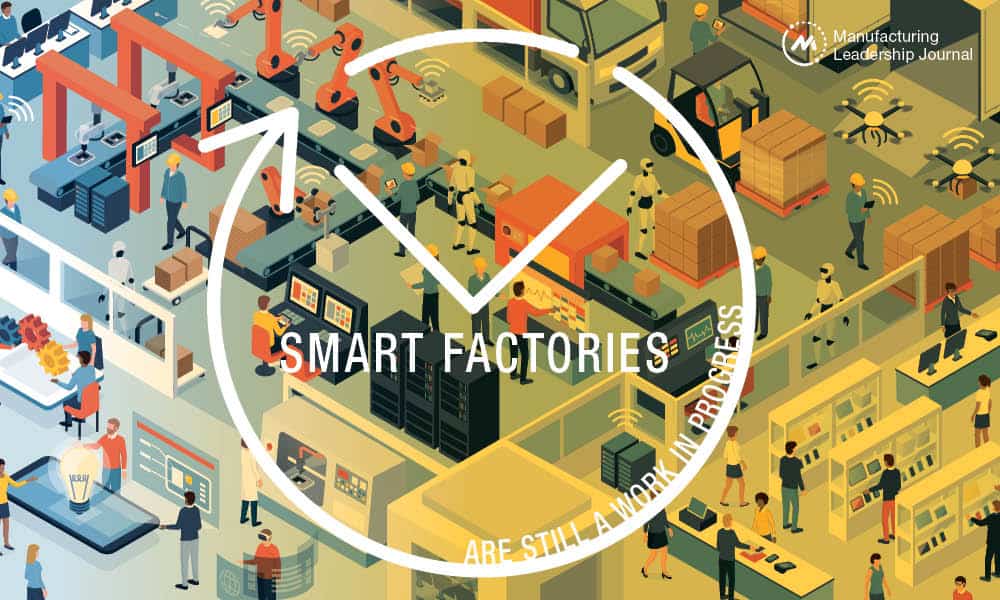
Manufacturers are moving ahead with creating smarter factories as they grapple with cultural resistance and integrating new technologies.

TAKEAWAYS:
● A majority of manufacturers say their investments in M4.0 technologies to create smart factories will continue unchanged this year.
● Most manufacturers are at an intermediate stage with M4.0 adoption.
● The most significant roadblock to implementing a smart factory strategy is an organizational structure or culture that resists change.
Tracking the evolution of factories and plants to become so-called smart facilities is a bit like trying to discern the movement of a glacier. You can watch intently but it is hard to detect change. And when change does occur, it is measured in inches. But like a glacier, over time the movement to smart factories and plants will encompass all a production facility does and in a profound way.
The manufacturing industry is inexorably marching toward a day when smart factories and plants, powered by intelligent, sensor-based networks that generate vast volumes of data that are analyzed by artificial intelligence systems, will operate with less human intervention. Highly automated, increasingly intelligent and flexible, the smart factory of the future beckons.
As we head toward that promised land, we look for markers along the way, indications that may tell us where we are making progress and where the obstacles to that progress may lie. The Manufacturing Leadership Council’s new Smart Factories and Digital Production survey sheds light on those markers.
Section 1: STATUS OF DIGITAL INVESTMENT AND ADOPTION
At the highest level, the industry’s posture with regards to investing in Manufacturing 4.0 technologies to create smart factories appears to be on solid footing. In the new survey, nearly 69% of respondents indicated that their M4.0 investments this year would continue unchanged from last year. Nearly 19% said they would increase investments and only 10% said their investments would decline (Chart 1). Concerns about a recession have evidently eased.
As manufacturers continue to invest in digitalization, they have moved from the initial stages of developing awareness and conducting research into M4.0 to action. Thirty percent of the respondents to the survey say they implementing small-scale pilots, experimenting with a range of projects, or scaling M4.0 companywide. Interestingly, about 31% report they are at the stage of conducting M4.0 readiness assessments, which, when completed, should spawn many pilots and projects (Chart 3).
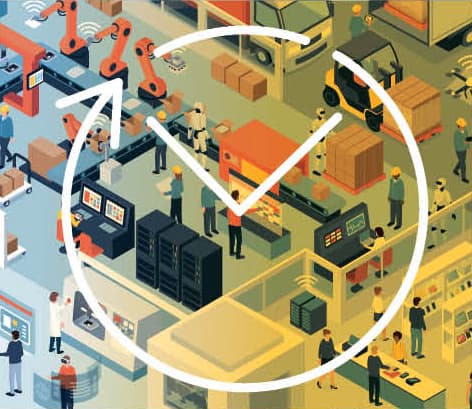
“The manufacturing industry is inexorably moving toward a day when smart factories and plants …will operate with less human intervention.”
When looked at the stage of adoption functionally – in R&D, product design, and in production and assembly, for example – a strong majority of respondents say they are at an “intermediate stage” with M4.0. Those at an “advanced” stage represent only single-digit or low double-digit constituencies (Chart 4).
Overall, when respondents were asked to assess the digital maturity level of their manufacturing operations, about 58% said that, on a scale of one to 10, they are in the three to five range, which supports the view that the industry has moved beyond the initial stages of M4.0 and is approaching an early majority of those embracing the digital model (Chart 2).
1. Economy Notwithstanding, Strong Majority Sees No Change to M4.0 Investments
Q: How do you expect your company’s outlook for the economy to influence M4.0 smart factory and production technology investments for 2024?

2. Nearly Half Are in Early Stage of Digital Maturity
Q: How would you assess the digital maturity level of your manufacturing operations?

3. Readiness Assessments, Roadmaps Dominate Stage of M4.0 Efforts
Q: Which activity best describes the primary stage of your company’s M4.0 digital efforts today?

4. Functionally, Most Firms Are in the Middle Stage of Digital Adoption
Q: At what stage of digital adoption are the following functions in your company?
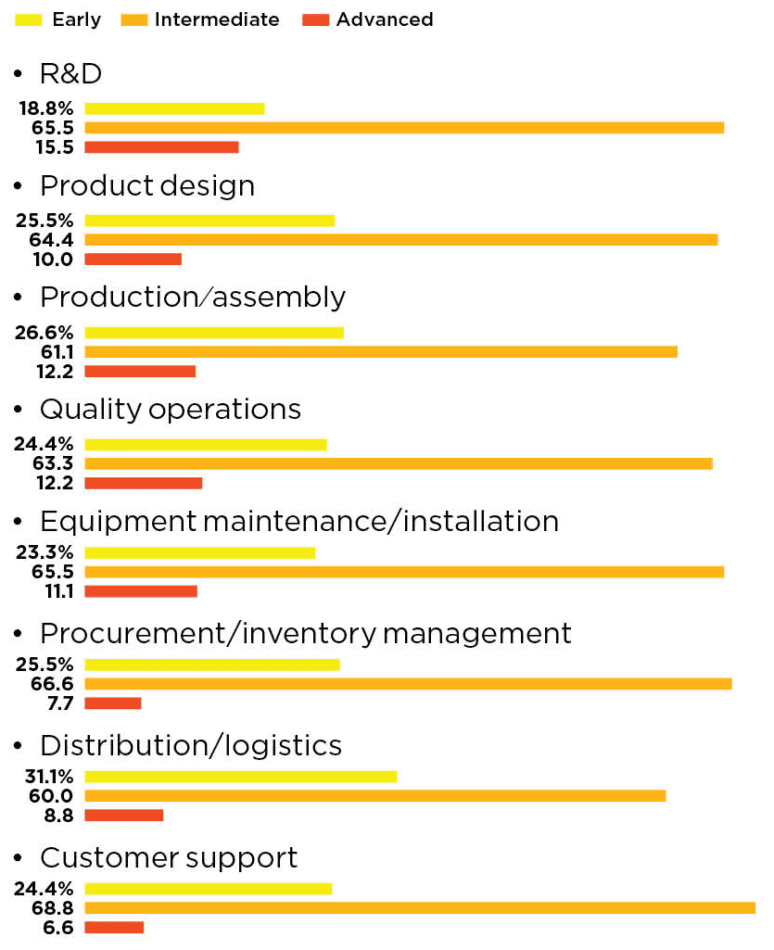
5. Few Have Fully Integrated Smart Factory Strategies With Business Strategies
Q: To what extent has your smart factory strategy been integrated with the company’s overall business strategy?
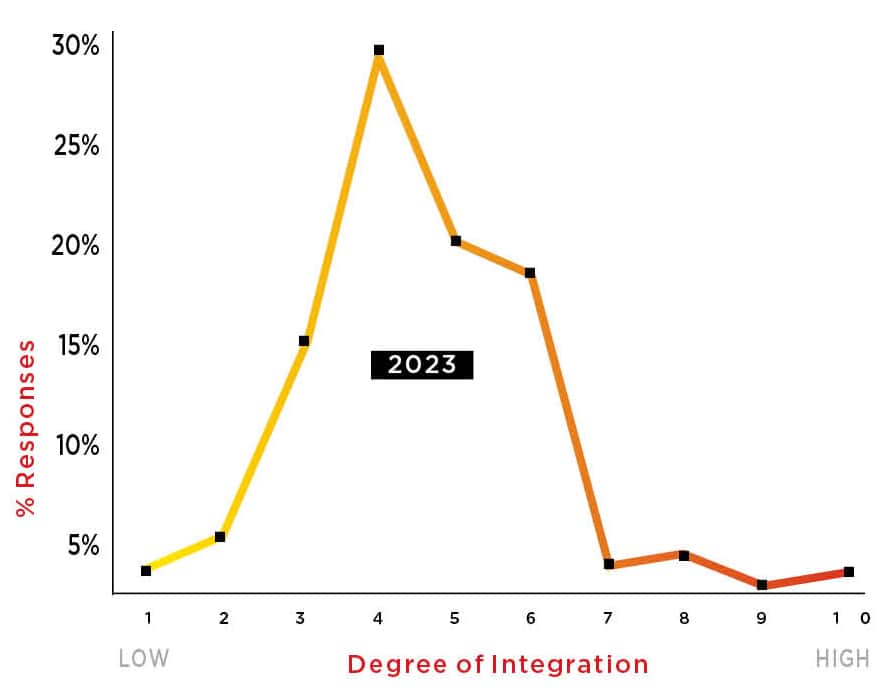
Section 2: MEASURING DIGITIZATION
Not surprisingly, only a fraction of manufacturers, 6.8%, report that they have “extensively” digitized their factory operations today. Most have either partially digitized or are in the planning stages of doing so. But when asked to anticipate the extent of digitization by 2026, 14.7% said they expect to be extensively digitized on an end-to-end basis in that timeframe (Chart 6).
Correspondingly, only a fraction of respondents, 4.5%, would be ready to say their factories are “very smart” today, but, once again, aspirations are high. By 2026, 11.3% expect to be able to affix that label to their operations. But for the moment, a majority of respondents, 53.4%, say their factories and plants are getting smarter but are still a work in progress (Chart 7).
6. More Fully Digitized Operations on the Horizon
Q: To what extent are your factory operations fully digitized end to end today, and what do you anticipate they will be by 2026?

7. “Smart” Factories Still a Work in Progress
Q: How “smart” do you consider your factory and plant operations to be today?

Section 3: FACTORY ORGANIZATION AND MANAGEMENT
So where is all this digital work heading? What do manufacturers expect their factory models to look like in the years ahead?
The idea and prospect of some level of autonomous operation is clearly on radar screens. Nearly half of the respondents, 48.8%, expect their future factory models to be autonomous, defined as fully integrated and automated, or partially autonomous, defined as some operations or processes conducted autonomously (Chart 8).
8. Autonomous Operations is on the Radar Screen
Q: What is the expected future state of your factory model?

9. A Majority Does Not See Self-Learning Factories in the Future
Q: Thinking about the impact of technologies such as AI and machine learning, to what extent would you agree or disagree with the following statement: “Tomorrow’s factory will evolve to be a self-managing and self-learning facility.”

Section 4: TECHNOLOGY USAGE
There is an expanding basket of advanced technologies manufacturers will be using to create their smart factories and plants.
When asked about adoption status on 21 technologies, the most striking thing was how strong planned adoption was by 2026. Eight of the technologies surveyed – for example, machine learning, edge computing, digital threads, AR/VR, and Metaverse technologies – all received 60% or higher planned adoption responses. Eight others garnered 50% or higher responses (Chart 10).
Interestingly, there is a split within the respondent base as to how significant an impact AI will have in operations, perhaps reflecting the still early stage of usage in many companies. Only 40% say that AI will be either very significant or somewhat significant, while nearly half, 49.4%, see AI as playing a minor role in the next few years (Chart 11)..
While it may be obvious that it takes a multitude of technologies to create a smart factory, the underlying message is that real power of being smart will only be realized when these technologies are integrated within the factory. That’s a whole new level of work ahead for manufacturers.
10. Strong Aspirations for a Basket of Technologies by 2026
Q: Where does your company stand in regard to the following technologies in its production operations?
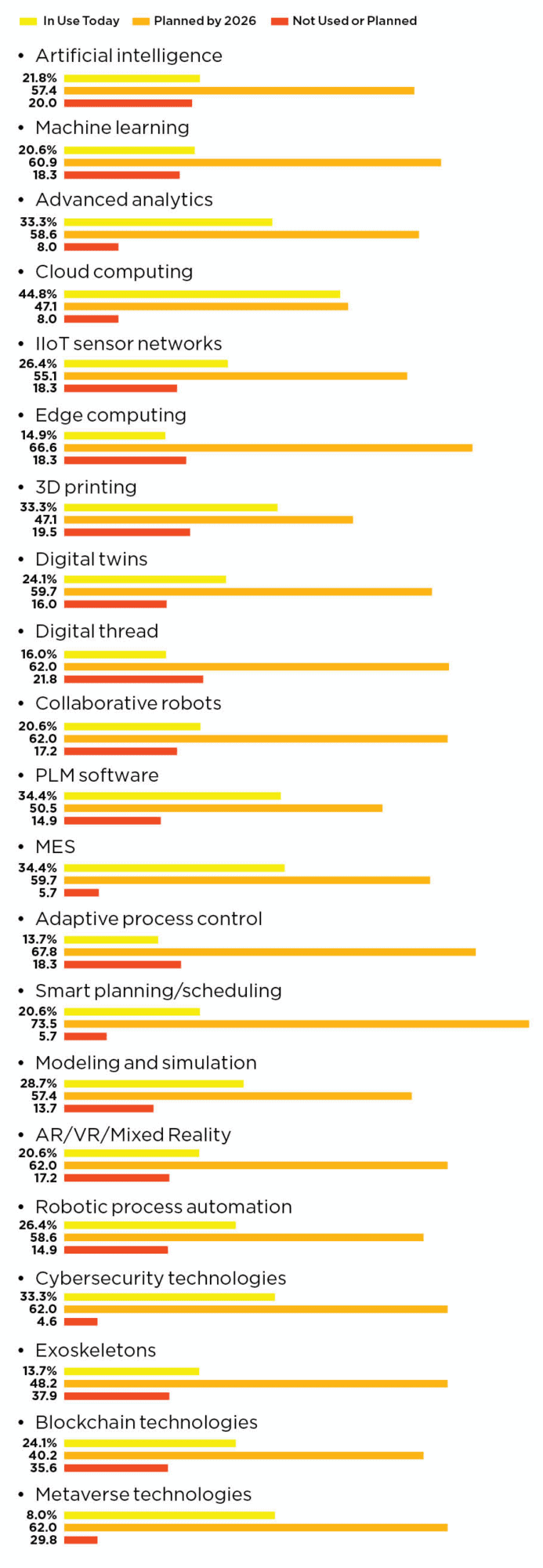
11. Views on AI Significance Diverge
Q: Looking ahead over the next few years, how significant an impact will AI have on your production operations?

Section 5: M4.0 OPPORTUNITIES AND CHALLENGES
Manufacturers also expect a basketful of benefits from creating smart factories and plants. Although there is no breakout factor, cost reduction, greater customer satisfaction, and higher financial returns top the list of expected benefits.
But when it comes to roadblocks in implementing a smart factory strategy, there is clearly a breakthrough factor – organizational structure or culture that resists change. More than 55% of respondents cited this factor as the primary issue in realizing their smart factory vision, considerably higher than a lack of skilled employees, cybersecurity issues, or the need to upgrade legacy equipment (Chart 12).
This may be why, when asked how well their smart factory strategies have been integrated with their company’s business strategy, very few respondents indicated that these two things were fully integrated (Chart 5).
As the famed management consultant Peter Drucker once said: “Culture eats strategy for breakfast.”
Is that glacier moving? M
12. Culture is Biggest Roadblock to Smart Factories
Q: What do you feel are your company’s primary roadblocks to implementing your smart factory strategy? (Select top 3)

13. Cost Reduction, Customer Satisfaction Chief Desired Benefits
Q: What are the most important benefits and opportunities your company hopes to realize from embracing a smart factory strategy? (Select top 3)

About the author:

David R. Brousell is Founder, Vice President, and Executive Director at the NAM’s Manufacturing Leadership Council.
Empowering Frontline Workers with 3D Models and IoT Data
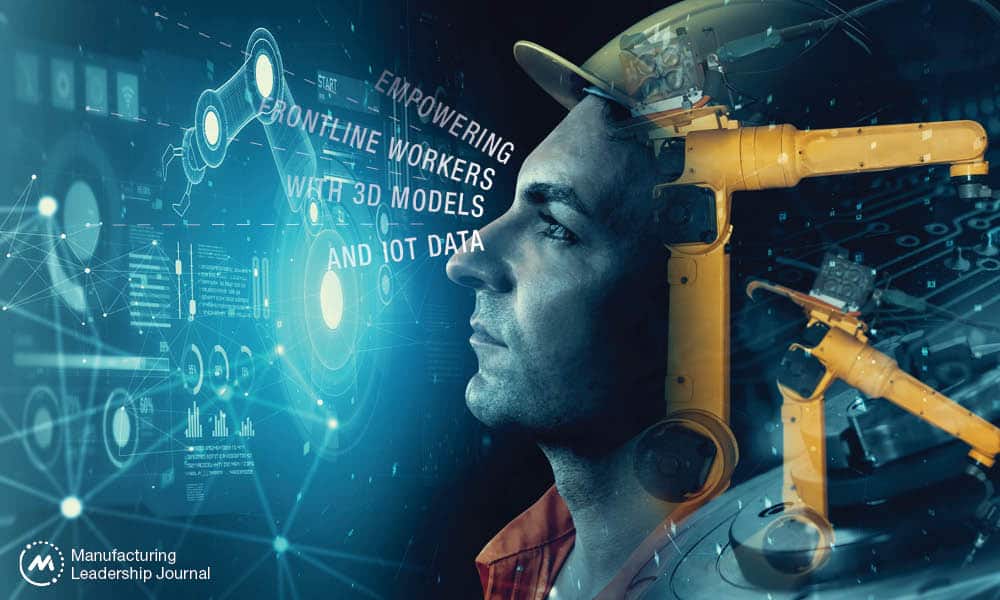
Advanced technology and data are helping manufacturers’ frontline workers become more productive.

TAKEAWAYS:
● The connected worker solution integrates MBD/E with IoT and AR to provide workers with real-time information, guidance, and feedback.
● Improved agility, compliance, and quality, increased efficiency, and empowered employees are just some benefits of the connected worker solution.
● Adopting a connected worker solution in manufacturing requires a strategic and flexible approach.
“Connected Frontline Workforce (CFW) applications are a strategic differentiator to successfully address daunting challenges in safety, sustainability, productivity, quality, and overall margin goals,” said Allison Kuhn, EHS/Sustainability, Future of Industrial Work Research Analyst, of LNS Research. “CFW applications are proven human-centric platforms that accelerate business value with real-time insights and knowledge management, leading to faster, better decisions.”
Discrete manufacturers face significant challenges, including global competition, rising customer expectations, increasing product complexity, and workforce shortage—all while needing to simultaneously capture significant improvements in productivity. These challenges necessitate a transformation towards agile, efficient, and resilient operations. Despite the automation of many dull, dirty, and dangerous tasks, frontline workers remain the vital component in this transformation. However, they are expected to perform today’s tasks at tomorrow’s speed with yesterday’s resources. A Forrester study1 found that 77 percent of frontline workers don’t have access to the technology they need to be productive. Strategic technological support is therefore crucial for actionable insights, enhanced human-machine interactions, effective collaborations across value chain, as well as for fostering improved decision-making and operational efficiency.
A model-based connected worker solution (hereafter called the “connected worker”) is a key technological enabler; it integrates model-based definitions and enterprise (MBD/E) with Internet-of-Things (IoT), augmented reality (AR), analytics, and artificial intelligence (AI). MBD/E, as a key facet of industrial digital transformation, uses 3D models as the authoritative source throughout the product lifecycle. The 3D model contains vital details like geometry, tolerance, manufacturing notes, as well as associated derivatives like manufacturing bill of materials, routing, work instructions, computer numerical control (CNC)/coordinate measuring machine (CMM) programs, control plan/characteristics, etc. With 62 percent of large manufacturers adopting or considering MBD/E strategies, and 57 percent of executives prioritizing them, according to Tech-Clarity2, the connected worker solution is timely and a booster to connected frontline worker initiative.

“The reality is that frontline workers are often expected to perform today’s tasks at tomorrow’s speed with yesterday’s resources.”
The strength of the connected worker lies in how 3D models amplify the impact of IoT, AR, analytics, and AI technologies, which have already been adopted or are being adopted by industry leaders to empower frontline workers. With the increasing adoption of MBD/E, these 3D models serve as a powerful booster by further enhancing the capabilities of frontline workers. The unique value that 3D models bring to connected workers includes
- Intuitive and immersive experience: Aligning with human visual and cognitive capabilities, 3D models combined with IoT and AR make it easier to understand complex real-time data, which speeds up decision-making and response times.
- One authoritative and always synchronized product and process data: As part of MBD/E, these models ensure that factory frontline workers/machines, and their upstream/downstream co-workers/systems, respectively, access consistent, updated information across the value chain.
The integration of 3D models with IoT, AR, analytics, and AI equips frontline workers with timely insights and ensures they are prepared to face the challenges of modern manufacturing, thereby enhancing productivity and competitiveness.
Benefits of the Connected Worker
The connected worker solution can help manufacturers achieve several benefits:
- Speed and agility: By providing workers with model-based work instructions, the solution can reduce the time and errors involved in manual and paper-based processes and enable faster and more flexible responses to changes and customer demands.
- Efficiency and cost: By connecting workers with model-based connected machines, the solution can optimize the use and performance of assets, and reduce downtime, waste, and maintenance costs.
- Quality and compliance: By enabling workers to perform end-of-line inspections and use data to solve problems, the solution can improve the quality and consistency of products and ensure compliance with standards and regulations.
- Frontline worker empowerment and engagement: Frontline workers benefit from on-the-job learn & do with intuitive work instructions in a 3D context, improved knowledge capture and sharing, and the elimination of non-value-added activities.
Connected Worker Use Cases and Case Studies
We present four examples of connected worker use cases that demonstrate how manufacturers can start with minimal investment yet reap significant benefits. These examples showcase practical and efficient applications of the connected worker concept in real-world scenarios.
1. Model-based Work Instructions and Execution
A case study of Vestas shows how a model-based connected worker solution can help workers assemble complex components with higher accuracy and efficiency, improving first-time build rate and better-quality outcomes.
Problem: Vestas had a dynamic build process, and detailed work instructions that were traditionally printed on hundreds of thousands of paper pages and sent out to more than 23,000 employees. Also, given the size and complexity of wind turbines, particularly with the recent uptick in global demand, Vestas employees required more in-context information to meet these challenges.
Solution: Vestas introduced PTC’s Manufacturing Solutions, which equipped machine operators with the relevant information needed to identify and complete tasks in the right sequence with the right tools—including role-specific digital work order information and instructions with rich CAD drawings and videos —all in a single interface. This solution will help ease the impact felt by the veteran employees retiring and combat the current volatility around employee retention.
2. Model-based Connected Machine
A large construction equipment manufacturer is exploring a model-based manufacturing strategy to avoid human errors and improve product and process quality by automating human-machine interaction with programmatic information extracted directly from the 3D model.
Problem: The manufacturer has many different types of machines, including welding, CNC, and CMM. There is a lot of manual work involved in copying and pasting engineering documents, process planning documents, control plans, and CNC/CMM programs between engineering and manufacturing operations. This results in significant delays in production preparation time and more errors in human transcription.
Solution: The manufacturer is implementing a model-based manufacturing strategy that starts with engineering by creating a single 3D product model that is leveraged by up to 100 downstream deliverables, including control characteristics details that flow automatically into welding, CNC, and CMM machines and which collects processing and testing results for further variation analysis.

“AR solutions help frontline workers view clear, detailed digital content in the context of their physical environment.”
3. End-of-line Inspection
A case study of Magna, an automotive supplier, shows how the solution can help workers inspect and verify the quality of products using AR and IoT devices, reducing defects and recalls.
Problem: There is very little room for error in the fast-paced automotive industry, and as vehicles become more complex, so does the assembly process. Many sequential steps need to happen within a given time frame. With manual processes and 2D paper-based instructions, training an operator on these steps is time consuming and challenging. Magna also had found that improperly fitted electrical plugs were passing continuity testing but then coming undone with movement—they required an extra layer of inspection for this part moving forward.
Solution: AR quality verification solutions help frontline workers view clear, detailed digital content in the context of their physical environment. PTC’s AR solution made it easy to create AR-guided tasks, checklists, and data capture. Magna used the AR solution to address its training outcomes, as trained workers can create first-person points of view of parts being assembled for trainees to follow. Training can also be enhanced with locational awareness, videos, images, and diagrams to provide extra content for new employees. Magna also used AR to enable operator inspection, intuitively creating quality inspection procedures that were more efficient and which reduced scrap, rework, and defects.
4. Closed-loop Problem-solving
A case study of Northrop Grumman, an aerospace manufacturer, shows how the connected worker solution can help workers analyze and visualize data from the factory floor, and identify and resolve issues that affect the quality and productivity.
Problem: Management challenged a business unit within Northrop Grumman to double its revenue in the next seven years. Struggling to unlock new capacity in its facility (even while running 24/7 operations) and to pull actionable data from relevant machinery, the director of Continuous Improvement conducted a Proof of Value and found that some of the company’s most important machinery was operating at a subpar OEE (Overall Equipment Efficiency) of 45 percent.
Solution: The Continuous Improvement solution has automated the lengthy and costly process of collecting data, and an initial analysis showed that the assets in question had the operational availability of 90–100 percent. These analytics empower frontline workers with the data they need to make informed decisions and to do targeted troubleshooting. Weekly reports empower the director to make decisions that have executive and operator buy-in. Waterfall analyses also unearthed an unexpected 50 hours of monthly re-work in a machine that wasn’t originally identified as a bottleneck. The implementation on the first line reduced cycle time and increased throughput that resulted in $2.5M additional potential revenue annually.

“This [a connected worker solution] involves empowering frontline workers with advanced technologies while ensuring the solution aligns with the company’s specific needs and readiness.”
Where to Start
To successfully implement a connected worker solution in manufacturing, it’s crucial to adopt a strategic and flexible approach. This involves empowering frontline workers with advanced technologies while ensuring the solution aligns with the company’s specific needs and readiness. Here’s how manufacturers can navigate this transformative journey:
- Use the agile composable approach: Prioritize a composable business architecture using modular building blocks. This approach allows for flexibility, scalability, and integration with existing systems, leading to cost-effective and agile solutions.
- Prioritize technology deployment with improvement to financial P&L: Identify top manufacturing bottlenecks and apply connected worker technology to eliminate and prioritize the most pressing issues. Identify the right solutions that will have the biggest impact on operational performance and drive fast time to value.
- Empower frontline workers with actionable insights: Assess and equip workers with advanced digital tools and access to critical insights when and where there is most impact. Doing so enhances efficiency, safety, and satisfaction, boosting productivity and quality.
- Implement MBD and integrate Product Lifecycle Management (PLM): Use fully defined 3D models as the authoritative source of the product and process data across the product lifecycle. Establish a strong PLM foundation to manage complex and detailed product data effectively. This ensures workers have access to accurate, up-to-date technical data facilitating informed decisions.
- Ensure closed-loop integration across the lifecycle: Connect engineering, manufacturing engineering, and shop-floor processes. Use IoT for real-time monitoring and feedback, and promote continuous improvement in product development and optimization.
- Frontline workers have yet to benefit directly from many of the promises of industrial digital transformation. This article strives to outline some of the most relevant tools leveraging data to empower frontline workers today, as well as to provide an introductory guide for those who are early on their adoption lifecycle. M
References
1. Williams, E. New research highlights massive opportunity to empower Firstline Workers with technology. Microsoft, December 14, 2018.
2. Boucher, M. Adopting a Model-Based Enterprise Strategy. Tech-Clarity, July 2, 2022.
About the authors:

Gonzalo Chavez is a senior analyst in Market Development, Connected Operations Solutions at PTC.

Howard Heppelmann is divisional vice president and general manager of PTC’s ThingWorx IoT Solutions.

Dirk Schart is senior director Go-to-Market at PTC and leads the global Vuforia marketing.

James Zhang is vice president of Market Development, IoT at PTC.
- Need more information: Contact the team at PTC
Four Steps to Scale M4.0 Adoption Organization-Wide
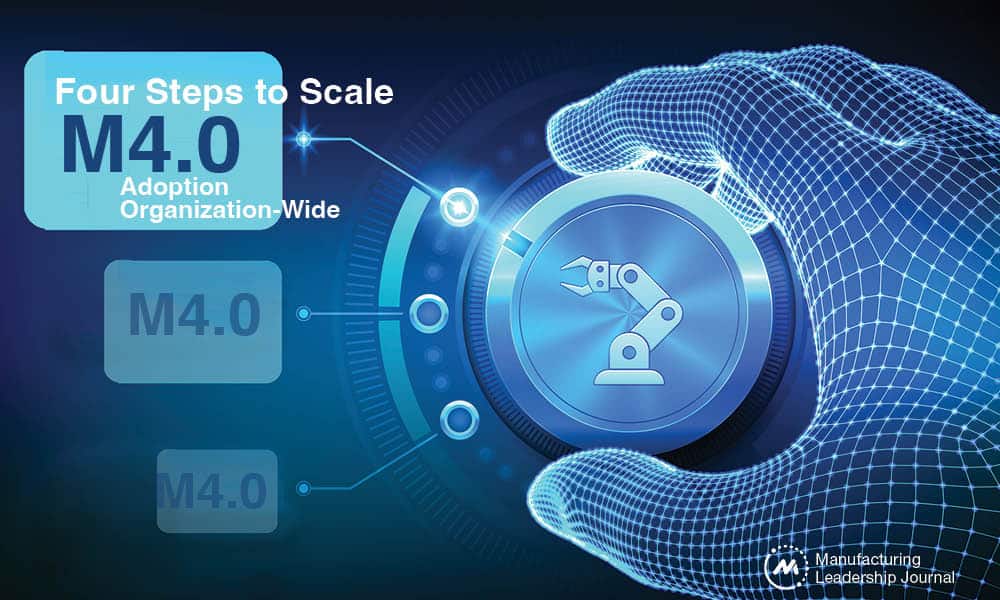
Want to reap Manufacturing 4.0’s benefits at scale? Let this four-step roadmap lead the way.

TAKEAWAYS:
● M4.0 has significant implications for industrial operations, integrating advanced technologies with traditional manufacturing processes.
● Adopting and scaling M4.0 requires an understanding of best-practices to avoid common mistakes and improve outcomes.
● A successful scaling process begins by examining the current and desired future state.
Why follow these steps?
The M4.0 transition is more than just the adoption of new technologies; it is a complete reimagining of design, production, and delivery methodologies. Successfully navigating this transformation requires a well-structured roadmap, a robust maturity model, and an effective transformation framework.
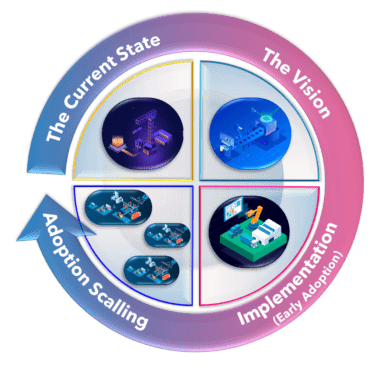 Adopting M4.0 is more nuanced than meets the eye. Following best practices at each phase helps to avoid these common mistakes when scaling M4.0’s adoption:
Adopting M4.0 is more nuanced than meets the eye. Following best practices at each phase helps to avoid these common mistakes when scaling M4.0’s adoption:
- Failing to fully integrate: M4.0 is not just about technological upgrades; it is about how these technologies are integrated into an organizational structure and leadership. Good use cases become great when embedded into a broader, cohesive strategy.
- Overlooking strategy: M4.0 success hinges on a culture of innovation and collaboration. Avoid the mistake of letting promising use cases stall at the pilot stage due to a lack of strategic direction.
- Underestimating the challenges of scaling: Scaling M4.0 solutions across an organization is complex. Ensure new solutions are compatible and synergistic with existing operations.
The Four-Step Approach
1. The Current State
Identifying gaps and opportunities for improvement
In pursuit of continuous growth and excellence, understanding the current state is vital. This process is not just about what we assess, but also about who contributes to this assessment. Insights should be inclusive, coming from all levels within the organization and from external sources.
Begin by asking:
- What are the core competencies? Where are improvements needed?
- Which gaps in operations can turn into growth opportunities?
- How can existing resources and capabilities be used to meet objectives?
These questions will help identify improvement areas and create action plans to address them. Be enthusiastic and proactive in finding the answers collaboratively.
Regarding methodologies, while frameworks like Six Sigma and Design Thinking offer structured routes towards improvement, their effectiveness lies in how they are applied. The ideal approach is one that yields comprehensive feedback, capturing diverse insights from outside and within, addressing various organizational dimensions.
2. The Vision
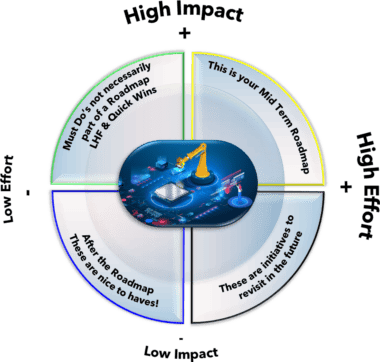
Defining the future state and prioritizing initiatives
Crafting a vision for the future within M4.0’s context requires cross-functional collaboration to establish clear, significant, and practical goals. With these in place, the most impactful and achievable initiatives can begin.
It is important to communicate not only enthusiasm for this vision but also its practicality in fostering innovation, efficiency, and competitiveness.
Here are key elements that align with M4.0’s three pillars of organization, technology and leadership:
From a customer-centric perspective: (Organization)
- Organizations must challenge themselves to think differently, innovate constantly, and deliver value in everything they do.
- The goal is to perceive products and services at their core, recognizing and emphasizing what makes them unique and valuable.
- Aim for products and services to positively transform customers’ experiences, driven by innovation and opportunity rather than constrained by tradition.
From a technology perspective: (Technology)
- Artificial intelligence (AI) and machine learning (ML): AI and ML enable manufacturers to optimize production, reduce costs, enhance quality, and boost customer satisfaction. They also play a role in new product design, demand prediction, and failure prevention.
- Robotic process automation (RPA): RPA allows manufacturers to increase efficiency, productivity, and safety. They complement human labor, performing complex tasks and safely handling hazardous materials.
- Enterprise IoT and cloud computing: These are key in connecting and monitoring our machines, devices, and systems in real-time; improving data collection, analysis, and decision-making capabilities; and facilitating remote access and control.
- 3D printing and additive manufacturing: These allow for the creation of customized, intricate products with reduced waste and costs and faster delivery. They are also essential for prototyping, material testing, and product repairs.
These technologies enable some of the most impactful innovations in modern manufacturing and are integral to a vision roadmaps.
From a C-level perspective: (Leadership)
- Culture and people: To achieve a future where digital solutions elevate human creativity, collaboration, and innovation, roles must transform to enhance capabilities rather than replacing them.
- Technological integration: Technology must become an intrinsic part of an organization’s DNA, enabling it to achieve objectives and revolutionize production and delivery methods.
- The ecosystem and parallel ecosystems: Manufacturers must aim to be leaders, not followers, in the market. Identifying the ecosystem, competitors, and the startup landscape is crucial. They must recognize and respond to market shifts, acknowledging that today’s business environment is interconnected and boundaryless.
3. Implementation and Early Adoption
The right partners with the right technologies for the right processes at the right time
The practical implementation of an M4.0 vision involves introducing disruptive technologies and innovative practices in a way that is both efficient and minimally disruptive to the operation. Implementing these changes is a complex process that necessitates adjustments in organizational culture, business models, processes, and skill sets.
To successfully navigate early adoption, the following is a sequential approach that highlights the interdependence of each step, creating a cohesive path forward:
- The right partners with the right technologies: It is crucial to collaborate with organizations that not only provide the necessary technological solutions but also understand and align with organizational culture and values. This partnership should be marked by agility, adaptability, and a proactive approach to facing challenges and seizing opportunities. After all, building long-term, mutually beneficial business relationships is a competency worth maturing constantly.
- The right technologies for the right process: The key to successful technology implementation is integration. This means creating a cohesive system from disparate elements, ensuring M4.0 solutions are interoperable, compatible, and complementary. While traditional systems like ERP, MES, SCADA, and BMS form part of this, the incorporation of IoT platforms with integrated analytics is essential. Such platforms provide comprehensive insights across all levels of the business.
- The right process at the right time: When selecting processes for early adoption, it is strategic to start with those the organization has mastered and are already mature. However, manufacturers must also consider how external variables, whether from outside the process or external to the company, can skew insights. These external influences can lead to inaccurate analytics, potentially jeopardizing decision-making and business performance. It is important to identify and account for these external variables, ensuring that all insights are thoroughly validated and verified before they are applied to strategic or operational decisions.
4. Adoption scaling
Evaluating and expanding the outcomes
Adoption scaling in Manufacturing 4.0 (M4.0) involves the process of strategically broadening the reach and impact of innovative solutions, transitioning from initial pilot stages to full-scale integration within an organization. Key challenges in this process include technical complexities, regulatory compliance, organizational adaptation and change management, social acceptance, and logistical coordination.
The four primary drivers and enablers of adoption scaling in the manufacturing sector include:
- Customization and personalization demand: The growing need for customized products calls for greater flexibility and agility in production processes.
- Efficiency and productivity pressure: Amidst rising competition and cost pressures, organizations must focus on optimizing resource utilization and minimizing waste to stay ahead.
- Environmental and social responsibility: The rising awareness around sustainable and responsible manufacturing practices compels manufacturers to adopt more eco-friendly and socially responsible methods. This commitment must reflect a company’s core values and resonate with its stakeholders and customers.
- Leveraging Industry 4.0 (I4.0) technologies: The accessibility and affordability of I4.0 technologies provide a unique opportunity for innovation and value creation. By harnessing these technologies, companies can drive transformational changes across our manufacturing landscape. M
About the Author:

Roberto Cisneros is the Director of IIoT Solution Architecture at Softtek
Dialogue: Using Innovation to Complement Workers

MIT is partnering with Amazon to develop best practices for introducing new technologies alongside quality jobs.

Dr. Julie Shah of the Massachusetts Institute of Technology joined the MLC’s Board of Governors in 2022. Since then, she has participated in MLC’s Rethink and Manufacturing in 2030 events, speaking about the use of AI in manufacturing and its implications for the manufacturing workforce. In October of last year, MIT announced a partnership with Amazon to research how best to use innovative technologies such as AI and robotics to complement rather than replace workers. The Manufacturing Leadership Journal recently sat down with Dr. Shah to discuss her work and the objectives of the partnership with Amazon.
Q: Could you describe your role at MIT and your areas of concentration from a research and teaching perspective?
A: I’m the H.N. Slater Professor in MIT’s Aeronautics and Astronautics department. I also co-lead MIT’s Work of the Future initiative, directing cross-disciplinary research on how innovation impacts jobs. My own AI and robotics lab aims to imagine the future of work by designing collaborative AI teammates that enhance human capability. I partner with companies to translate these ideas into real-world industries — manufacturing, healthcare, transportation, aerospace, and more. At MIT, I teach classes focused on human-centered design of AI, robotics, and autonomous systems. And through cross-campus initiatives like the Work of the Future, we’re engaging policymakers, academics, and industry leaders to shape a more positive future enabled by technology.
Q: You were one of the key people involved with MIT’s Work of the Future initiative, a report on which was published in 2020. Could you summarize some of the key findings of that report?
A: MIT’s former president, Rafael Reif, convened a three-year task force back in 2018 during a time of high anxiety about automation and its potential to displace jobs. Some forecasts predicted that up to half of all jobs were vulnerable. The task force took an interdisciplinary approach to evaluating those claims. What we found was a much more nuanced story — new technologies did not appear to be eliminating jobs outright, but technological progress was also not contributing to widely shared prosperity.

“We want to grow a community that advances automation responsibly and inclusively.”
For example, our researchers found that robots are often inaccessible for small and medium enterprises, which employ nearly half the US manufacturing workforce. This leads to unequal productivity distribution, with large firms able to achieve much higher productivity than smaller ones.
The main takeaway, and the vision for building on the task force’s work, is that we should strive to align innovation with good outcomes for all workers.
Q: Very interesting. Pivoting topics a bit, last fall, MIT and Amazon announced a partnership to fund research into best practices for introducing new technologies alongside quality jobs. What are the goals there and how do you see that effort building on the Work of the Future report?
A: The vision is to shape a future where innovation complements rather than displaces workers. We also want to grow a community advancing automation responsibly and inclusively.
To study this, we recently launched an “Automation Clinic” at MIT where students team up with companies to see firsthand how tech impacts jobs. Over two years we’ve worked with 20+ firms in sizes ranging from 20 to 1,000+ employees. We’re making short docuseries showing real use cases.
Going forward, we’ll expand these learnings through new partnerships across the country. We already have interest from Ohio, Indiana, and Oklahoma. The idea is getting more schools, students, and employers exchanging ideas for “positive-sum” automation that drives productivity but also employee flexibility. Our Amazon collaboration specifically supports grad students to embed directly to study the introduction of new technologies in small and medium firms.

“Our Amazon collaboration specifically supports the study of new technologies in small and medium firms.”
Q: Is there a timeline yet for publications or outcomes from that effort?
A: We plan to publish initial findings as a series of case studies in mid 2024. Longer-term, the goal is to translate insights from the research into educational resources and training materials for broader distribution, both to industry practitioners as well as for engineering education.
Q: Great, look forward to seeing those results. Finally, I understand you also have a working group focused specifically on generative AI. Can you discuss the goals and composition of that effort?
A: MIT’s Work of the Future initiative has convened a cross-disciplinary group of industry and academic leaders to study how the design and use of generative AI tools can enable higher-quality jobs and more inclusive access to the latest technologies.
On the research side, our scholars are already conducting studies analyzing real-world deployment of generative AI systems and their impacts on employees. We’ll be publishing those as academic papers as well as case studies of best practices.
The working group itself just kicked off and meets quarterly to share knowledge and identify guidelines. We’ll also host annual summits for broader discussion among corporate AI leaders. M

FACT FILE: Massachusetts Institute of Technology
Headquarters: Cambridge, MA
Employees: 16, 327
Founded: 1861
EXECUTIVE PROFILE: Dr. Julie Shah
Title: H.N. Slater Professor of Aeronautics and Astronautics at MIT. Leads the Interactive Robotics Group of the Computer Science and Artificial Intelligence Laboratory.
Education: Ph.D from MIT in 2011.
Previous Roles:
– Boeing Research and Technology
About the author:

David R. Brousell is Co-Founder, Vice President, and Executive Director at the NAM’s Manufacturing Leadership Council.